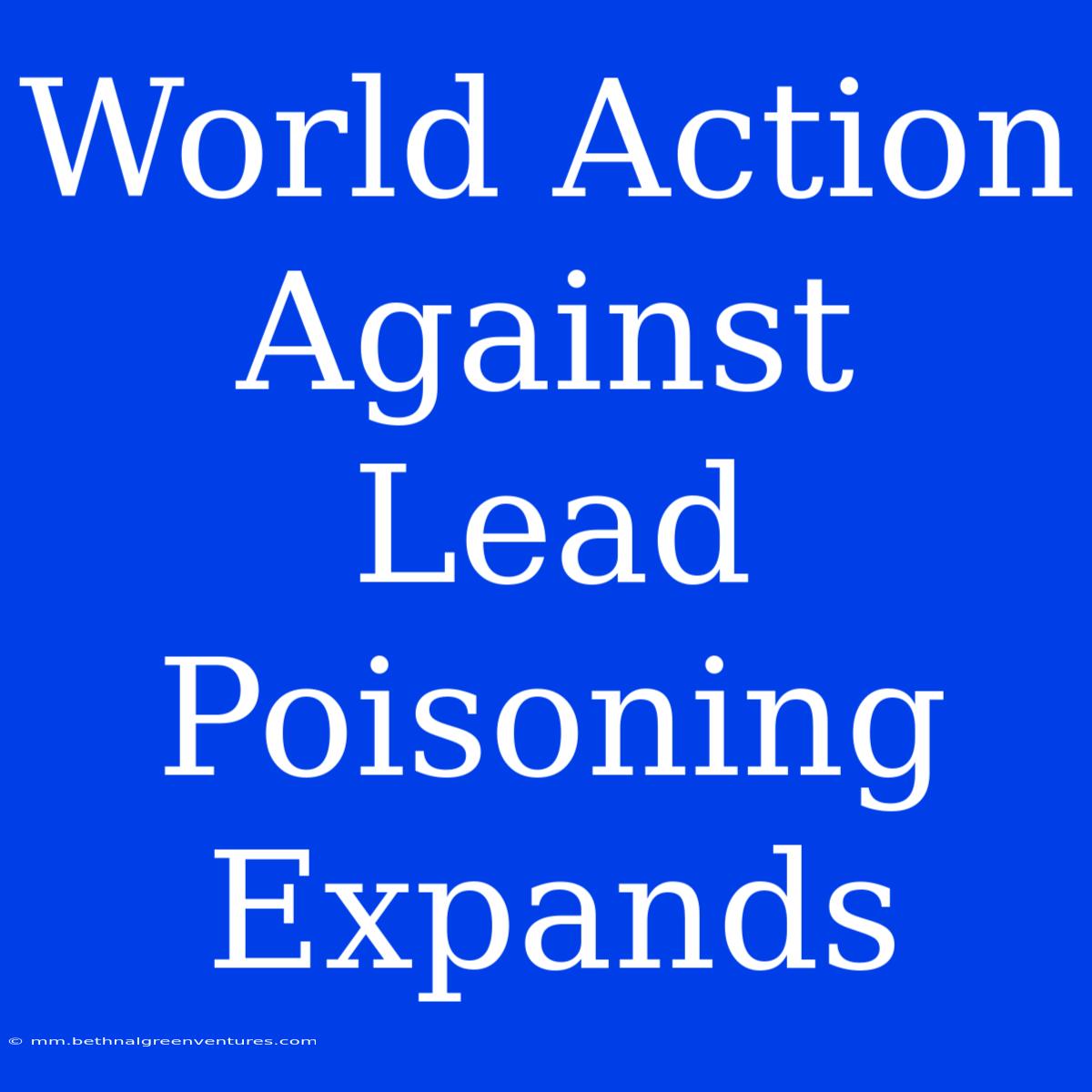World Action Against Lead Poisoning Expands: A Global Effort to Protect Children
Is lead poisoning a global health concern? Yes, and it's a critical one, especially for children. **_Editor Note: _**The World Health Organization (WHO) has recently announced a global expansion of its efforts to combat lead poisoning, recognizing its devastating impact on children's health and development.
This is a crucial step in a global battle against a silent threat. Lead poisoning, a preventable condition, can cause severe, long-lasting damage to children's brains and bodies. It can lead to learning disabilities, behavioral problems, and even death.
This article explores the expansion of the World Action Against Lead Poisoning and analyzes its key aspects, highlighting the critical need for collective action to protect children from this silent threat.
Analysis: This analysis delves into the WHO's initiatives, examining the causes and consequences of lead poisoning, the importance of early detection and intervention, and the critical role of government policies and community engagement in preventing lead exposure.
Key takeaways of World Action Against Lead Poisoning:
| Aspect | Description |
|---|---|
| Global Reach | The WHO's initiative encompasses a wide range of countries, targeting areas with high lead exposure. |
| Focus on Children | The initiative prioritizes protecting children, the most vulnerable group to lead poisoning. |
| Comprehensive Approach | The initiative involves multiple interventions, including lead testing, environmental remediation, and public awareness campaigns. |
| Collaboration | The WHO works with governments, NGOs, and communities to implement the initiative. |
World Action Against Lead Poisoning
The initiative aims to reduce lead poisoning through a multi-faceted approach, targeting critical aspects like:
**1. ** Early Detection:
Introduction: Early detection is vital in preventing long-term health effects.
Facets:
- Lead Testing: Regular lead testing of children is crucial for identifying exposure early.
- Blood Lead Levels: Blood lead levels are used to assess the severity of lead poisoning and guide intervention strategies.
- Early Intervention: Prompt treatment and intervention are critical in minimizing the potential damage caused by lead poisoning.
Summary: Early detection and intervention are essential to prevent severe health consequences from lead poisoning, ensuring timely care and minimizing long-term effects.
**2. ** Environmental Remediation:
Introduction: Reducing lead exposure in the environment is a fundamental step in preventing lead poisoning.
Facets:
- Lead in Paint: Old paint containing lead is a primary source of exposure, requiring removal or careful management.
- Lead in Soil: Lead contamination in soil can be ingested by children, necessitating soil remediation.
- Lead in Water: Lead pipes can contaminate drinking water, necessitating water testing and replacement.
Summary: Environmental remediation plays a pivotal role in reducing lead exposure, protecting children from the harmful effects of lead.
**3. ** Public Awareness:
Introduction: Public awareness campaigns are crucial in educating communities about the risks of lead poisoning and promoting preventive measures.
Facets:
- Education and Outreach: Raising awareness about lead poisoning through targeted campaigns and educational programs is vital.
- Safe Practices: Promoting safe practices like avoiding lead-based paint, ensuring proper water testing, and maintaining safe food handling can significantly reduce lead exposure.
- Community Engagement: Engaging communities in the fight against lead poisoning is crucial for creating lasting change.
Summary: Public awareness campaigns empower individuals and communities to protect themselves and future generations from lead poisoning.
FAQs by World Action Against Lead Poisoning
Introduction: Frequently Asked Questions (FAQs) provide valuable information for individuals seeking to understand lead poisoning and its prevention.
Questions:
- What are the symptoms of lead poisoning? Symptoms of lead poisoning include headaches, fatigue, abdominal pain, and developmental delays in children.
- What are the sources of lead exposure? Lead exposure can occur through lead-based paint, contaminated soil, lead pipes, and certain food and water sources.
- How can I prevent lead poisoning? Follow safe practices like using lead-free paint, ensuring proper water testing, avoiding lead-contaminated food and water, and maintaining good hand hygiene.
- What should I do if I suspect my child has been exposed to lead? Contact your child's doctor immediately for testing and guidance.
- What are the long-term effects of lead poisoning? Lead poisoning can cause irreversible damage to the brain, nervous system, and other organs, leading to long-term health problems like learning disabilities and behavioral issues.
- Is lead poisoning reversible? While some lead poisoning effects can be mitigated through early intervention, some damage can be irreversible.
Summary: Addressing common concerns and misconceptions through FAQs fosters informed action and empowers communities to take proactive measures against lead poisoning.
Tips by World Action Against Lead Poisoning
Introduction: These practical tips provide guidance for individuals and families seeking to reduce lead exposure and protect themselves from lead poisoning.
Tips:
- Test Your Home: Have your home tested for lead, especially if it was built before 1978.
- Avoid Lead-Based Paint: Use lead-free paint for renovations and repairs.
- Maintain Water Pipes: Test your water for lead and replace lead pipes if necessary.
- Practice Safe Food Handling: Avoid lead-contaminated food and water, especially for children.
- Wash Hands Regularly: Wash your hands frequently to prevent lead ingestion, especially after playing outdoors.
Summary: Following these simple tips can significantly reduce lead exposure and protect children from this preventable health threat.
Summary by World Action Against Lead Poisoning
Summary: The World Action Against Lead Poisoning initiative represents a critical step in reducing lead poisoning globally, prioritizing early detection, environmental remediation, and public awareness.
Closing Message: By joining forces and implementing comprehensive strategies, the world can effectively protect children from the devastating effects of lead poisoning, building a healthier and brighter future for all.
